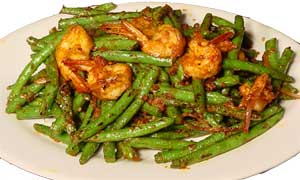Malaysian Food Guide


Malaysian cuisine, like its people finds its roots among Chinese, Thai, Arab and Indian influence. These ethnic groups have also merged within the Malaysian ethos and are an intrinsic part of the culture and food of the region. Malay dishes are mostly hot and spicy - in the belief that hot curry eaten on a hot day helps cool the body. The heady aroma of traditional Malay food cooked with tantalizing spices and simmering gravy will leave you wishing for more.
Malaysian Food
Rice is an integral element in most Malay meals. Other than rice, noodles are also accompaniments to most spicy gravies. Be it the Yee Meen (pre-fried noodles) or Tang Hoon (transparent noodles made from green beans), Malaysian food offers a few noodle and vermicelli varieties that make for the carbohydrate source. Seafood is popular as also beef and mutton. Pork never finds its way to most traditional Malay dishes due to religious reasons.
Roti Jala is a malay pancake made of flour, coconut milk, eggs and butter. This lacy crepe goes well with rich curries and gravies. Prawns, shrimp, squid and fish are popular in Malay cuisine. Seafood is either grilled after seasoning and wrapping in banana leaves or stuffed with belachan.
Traditional Malay food makes use of tantalizing herbs such as lemon grass, daun kemangi (a type of basil), nutmeg, bunga kantan(wild ginger buds) and pandan (screwpine) leaves.
Dried spices such as star anise, fenugreek, coriander, cumin and fennel are frequently used to flavor Malayan dishes. Some of the unique spices used in Malaysian food lend different colors to rice. Fresh chili paste, onions and garlic find themselves in most Malaysian dishes.
Fresh coconut milk is also an integral part. Typical Malayan gravy has fresh and dried ingredients ground into a paste called rempah. This is sautéed in oil to bring out the aroma. Coconut milk is used to add a creamy richness. Though soups are not usually a must-have in a Malay meal, the Sup Kambing (mutton soup) is a regional delicacy.
A key ingredient in Malay cuisine is belachan. It is pronounced as blah-chan. It makes for an interesting twist in any Malay meal. Belachan is used to make sauces and gravies and can lend richness to a dish. Made from baby shrimps, belachan is available as bricks or cakes. Roast a small lump and pound with fresh chilies and add limejuice... and you have belachan ready to be used. In fact it is used in Thai, Vietnamese and Indonesian cuisine. There are subtle differences in the cooking styles in different regions of Malaysia. The Kelantanese cuisine is more like Thai food whereas cuisine from Kedah state tends to be influenced by Indian spices.
Coconut milk, palm sugar and freshly grated coconut are essential ingredients in most Malaysian desserts. Pulut Hitam is a black sticky rice porridge made with coconut milk and sago. The Cendol is made with chilled coconut milk and coconut palm sugar and smooth rice. ABC or Air Batu Campur is a Malaysian dessert prepared with sweet corn, red beans, jelly grass and topped with colorful syrups and condensed milk and slathered with shaved ice.
Enjoy an astonishing variety of exotic fruits in Malaysia - starfruit, lychees, mangosteens, pineapples, bananas, melons and durian. The durian is a Malaysian fruit that is encased in a heavy green shell that has spiky thorns. Its characteristic pungent smell doesn't appeal to many though.
Popular Malay dishes
Satay: The Satay is probably one of the most popular Malay dishes - meat (mutton, chicken or beef) barbecued over glowing charcoal and eaten with ground peanut sauce accompanied by ketupat (compressed rice steamed in banana leaves).
Beef Rendang (Malay Spiced Coconut Beef): This spicy dish is a specialty that is served during Ramzan and Eid and the Malay New Year. The meat is coated with tangy spices and simmered after dousing it with rich coconut cream.
Sambal Udang (Spicy Prawns): Prawns or shrimps are cooked with belachan and garlic, chillies, tomatoes and tamarind paste.
Ayam Masak Merah (Red-Cooked Chicken): Chicken pieces are pan fried a golden brown and cooked in a spicy tomato sauce.
Other popular Malay dishes are Sambal Udang, Sambal Sotong, Ayam Panggang and Sambal Tahu Goreng. A favorite noodle dish of Malay cuisine is Laksa and is served in a tangy fish gravy-like soup. Different Malay cooking styles are Masak Lemak (coconut), Masak Pedas (sambal, hot chillies), Masak Assam (tamarind), Masak Merah (tomato sauce), Masak Hitam (dark soy) and Masak Assam Pedas (hot chillies with tamarind and sambal).
Malay Recipes
Beef Rendang
1½ lb beef cut into 1½ to 2-inch chunks
4 cups thick coconut milk
2 stalks lemongrass, slightly crushed
3 tbsp vegetable oil
juice of 1 lime
2 cups desiccated or freshly grated coconut
2 tsp sugar
salt and pepper
4-5 tbsp chili paste
1½-inch fresh ginger, peeled, sliced
1½ inch fresh turmeric root peeled and sliced
Marinate beef with salt and pepper for half an hour. Grind ginger, turmeric root and chili paste with little salt. Roast grated coconut on a slow flame till golden brown. Pound it to a paste after it has cooled. Stir-fry the ground paste on a high flame.
Add coconut milk and gently bring to a boil. Add marinated beef pieces and cook for about 10 minutes. Add seasonings and salt and pepper. Simmer for nearly 1 hour and keep stirring often to prevent it from sticking to the bottom of the pan. Add roasted coconut paste after half an hour of cooking and let the curry thicken. This spicy beef dish goes well with Nasi Lemak (Coconut Rice) or Lontong (Rice Rolls).
Chicken Satay
1 lb boneless chicken
1 tsp turmeric powder
4 tbsp sugar
12 shallots
6 cloves garlic
2 inch turmeric root
1 tsp white peppercorn
1 tsp coriander seeds
2 tsp fennel seeds
2 tsp cumin
1 tsp belacan
2 seedless cucumber, sliced
2 onions slices
4 tbsp oil
1 lemongrass stalk
Grind shallots, garlic, pepper, coriander, fennel, cumin seeds, turmeric and belachan to a paste and add sugar. Marinate chicken strips with half the satay marinade for about 6 hours. Grill on a hot charcoal barbecue until golden brown. Keep basting it with sugar and oil mixture. Serve with satay sauce and cucumber slices, onion wedges and Malay rice cakes.
Satay sauce is made with onions, garlic, chilli paste, belachan and lemon grass. Also added are tamarind pulp, coconut milk, sugar and salt, nuts and peanuts. Pound roasted peanuts and grind chilli paste with onions, garlic, belachan, lemongrass and nuts. Sauté the ground paste in oil and add tamarind juice, coconut milk, sugar and salt. Bring to a boil on a slow simmering flame. Add pounded peanuts till sauce is of desired consistency.
Sambal Udang (Spicy Prawns)
1 lb medium to large-sized prawns or shrimp
4 tbsp peanut or vegetable oil
1 large onion, sliced
2 ripe tomatoes, quartered
1 tbsp tamarind paste
1 cup water
1 tsp palm sugar or dark brown sugar
salt to taste
8 shallots
2 tsp belacan
4 cloves garlic
5 tbsp chili paste
4 macadamia nuts
Grind shallots, garlic, belachan, chilli paste and nuts. Stir fry this paste in oil and add tomatoes, onions and tamarind paste. Add sugar and salt. Reduce till the sauce thickens. Add prawns and stir-fry. Serve with hot steamed rice.
Ayam Masak Merah (Red-Cooked Chicken)
3 lb whole chicken, cut into 8-10 parts,
2 tbsp turmeric powder
1 tbsp salt
1 cup red onions, chopped
2 tbsp ginger, grated
4 cloves garlic, minced
1 can tomato puree
½- cup chili paste
3 tbsp hot chili sauce
1 cup tomato ketchup
2 tbsp dark sweet soy sauce
1 large onion, cur into rings
½ tbsp sugar
salt to taste
2 cups water
3-4 kefir lime leaves
vegetable oil for pan frying
fresh coriander leaves for garnishing
Smear chicken pieces with turmeric powder and salt and let it stand for about 40 minutes. Heat oil in a wok to fry the chicken till light golden brown. Drain and keep aside. Add red onions, ginger, garlic and chili paste and stir-fry. Add tomato puree, dark soy sauce, hot chili sauce and salt and sugar.
Add lime leaves and 2 cups of water and let the sauce boil. Reduce on low flame for about 10 minutes. Add fried chicken pieces and bring to a boil. Simmer for about 30 minutes. Garnish with fresh coriander leaves and serve on a bed of hot steamed rice.
Top of the Page: Malaysian Food Guide
Tags:#Malay food #traditional Malay food #Malay cuisine #malaysian recipes #belacan recipe
 Foodie in You
Foodie in You Chicken Breast Recipes
Easy Salad recipes
Chicken Salad Recipe
Asian Food Recipes
 Filipino Cuisine
Filipino Cuisine Japanese Food Recipe
Chinese Food Recipe
Chinese Sauce
Beijing Duck
Dim Sum
Malaysian Food
Thai Food Recipe
Teriyaki Sauce
American Food Recipes
Cajun Food Recipe
Mexican Food Recipe
European Food Recipes
 Tiramisu Cake
Tiramisu Cake German Food
French Cuisine
Quiche Recipe
Mediterranean Recipe
Frittata Recipe
Greek Food
Type of Pasta
Pasta Salad Recipe
Tartar Sauce
Marinara Sauce
Jamaican Food
Moroccan Food
Top of the Page: Malaysian Food Guide
Popularity Index: 101,599

